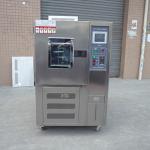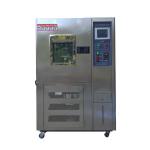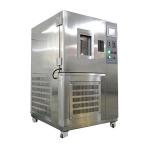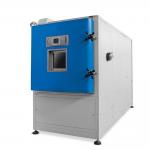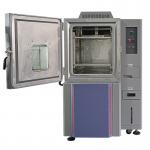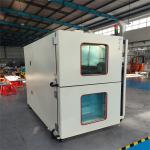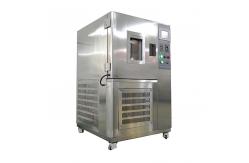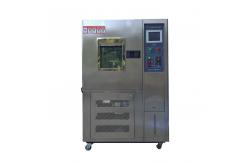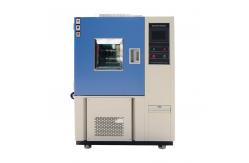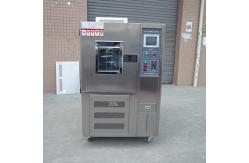In the highly competitive automotive industry, the durability and
reliability of components are non-negotiable. The customized Ozone
Aging Test Chamber for the Automotive Industry emerges as a vital
tool for manufacturers and suppliers, enabling them to ensure that
their products can withstand the harsh environmental conditions and
the corrosive effects of ozone over time. This specialized test chamber is designed to replicate and control
ozone-rich environments, specifically tailored to the unique
requirements of the automotive sector. It is used to test a wide
range of automotive components, including rubber seals, hoses,
belts, and plastic trim. The primary objective is to evaluate the
resistance of these materials to ozone-induced degradation, which
can lead to cracking, embrittlement, and loss of functionality. By
subjecting components to accelerated ozone aging tests,
manufacturers can optimize material selection, improve product
designs, and enhance the overall quality and lifespan of automotive
parts. - Robust and Sealed Chamber Construction
- The ozone aging test chamber for the automotive industry is
constructed with a heavy-duty stainless steel frame and walls. The
stainless steel material is chosen for its excellent resistance to
corrosion, which is essential as ozone can be highly reactive. The
chamber is carefully sealed to prevent any leakage of ozone,
ensuring a consistent and controlled test environment. The door is
equipped with a reliable gasket and a secure locking mechanism to
maintain the integrity of the enclosure. The interior of the
chamber is designed to be smooth and easy to clean, minimizing the
potential for any contaminants to affect the test results.
- Precision Ozone Generation and Concentration Control System
- The chamber features an advanced ozone generation system. It can
produce ozone with a high degree of accuracy and stability. The
concentration of ozone can be precisely controlled within a wide
range, typically from 20 parts per million (ppm) to 500 ppm, which
is relevant for simulating the ozone levels that automotive
components may encounter in different regions and usage scenarios.
The system utilizes state-of-the-art ozone generators and sensors.
The sensors continuously monitor the ozone concentration inside the
chamber and provide real-time feedback to the control unit. The
control unit then adjusts the ozone generation rate to maintain the
desired concentration level. This level of precision allows for
highly accurate and repeatable tests.
- Accurate Temperature and Humidity Control
- In addition to ozone concentration, the chamber also offers precise
temperature and humidity control. The temperature can be maintained
within a range of -10°C to +60°C, with an accuracy of ±0.5°C. The
humidity control range extends from 30% to 90% relative humidity,
with an accuracy of ±3% RH. Temperature and humidity play important
roles in the ozone aging process, as they can affect the rate of
chemical reactions. The chamber's control system ensures that these
environmental factors are kept constant and within the specified
tolerances, providing a more realistic simulation of real-world
conditions. For example, in hot and humid regions, automotive
components may experience more severe ozone-induced degradation,
and this chamber can accurately replicate such conditions.
- Intuitive Control Panel and Data Acquisition System
- The equipment is equipped with an intuitive control panel that
allows operators to easily set and adjust the test parameters,
including ozone concentration, temperature, humidity, and test
duration. The control panel also provides real-time displays of the
current values of these parameters, as well as any alarms or
warnings. The chamber is integrated with a comprehensive data
acquisition system. It records all relevant test data, such as
ozone concentration profiles, temperature and humidity histories,
and any changes in the physical properties of the test samples. The
data can be stored in a built-in memory or exported to external
storage devices for further analysis. The system can also generate
detailed test reports in various formats, facilitating easy
documentation and sharing of results.
- Sample Fixturing and Placement Options
- The chamber is designed to accommodate a variety of automotive
component sizes and shapes. It can be equipped with adjustable
racks, trays, and holders to ensure proper positioning and exposure
of the test samples. The sample fixtures are made of materials that
are resistant to ozone and do not contaminate the test environment.
This flexibility allows for the testing of different products, from
small rubber seals to large plastic panels or hoses. For example,
rubber door seals can be placed on racks in a way that mimics their
actual installation position in a vehicle, ensuring that the test
accurately reflects their performance in real-world use.
- Ozone Concentration Range and Accuracy
- As mentioned, the ozone concentration can be adjusted from 20 ppm
to 500 ppm, with an accuracy of ±5% of the set value. This wide
range enables the testing of materials that may be exposed to
different levels of ozone in various automotive applications. For
example, components in urban areas with higher pollution levels may
experience more ozone, while those in rural areas may face lower
concentrations. The accurate control of ozone concentration ensures
that the test results are reliable and comparable.
- Temperature Range and Rate of Change
- The temperature range of -10°C to +60°C allows for the simulation
of a diverse range of climatic conditions. The rate of temperature
change can be adjusted up to 3°C per minute. This rapid temperature
change capability is useful for testing the thermal stability of
automotive components in combination with ozone exposure. For
instance, during a vehicle's startup in cold weather or when parked
in direct sunlight in hot weather, components may experience sudden
temperature changes while being exposed to ozone in the atmosphere.
- Humidity Range and Rate of Change
- The humidity range of 30% to 90% RH, with a rate of change of up to
5% RH per minute, provides a comprehensive assessment of the effect
of moisture on ozone aging. High humidity can accelerate the
degradation of some automotive materials, while low humidity may
have a different impact. The ability to control humidity precisely
helps in understanding the complex interactions between ozone,
temperature, and humidity. For example, in a humid coastal
environment, rubber hoses may be more prone to ozone-induced
cracking compared to a dry desert environment.
- Testing Volume and Payload Capacity
- The chamber offers a customizable testing volume, with options
ranging from 0.3 m³ to 5 m³. The payload capacity can be adjusted
according to the size and weight of the test samples, with a
maximum capacity of up to 200 kg. This allows for the testing of a
significant number of samples or larger and heavier automotive
components. For example, a batch of engine hoses or a set of
plastic bumper covers can be tested simultaneously.
|
